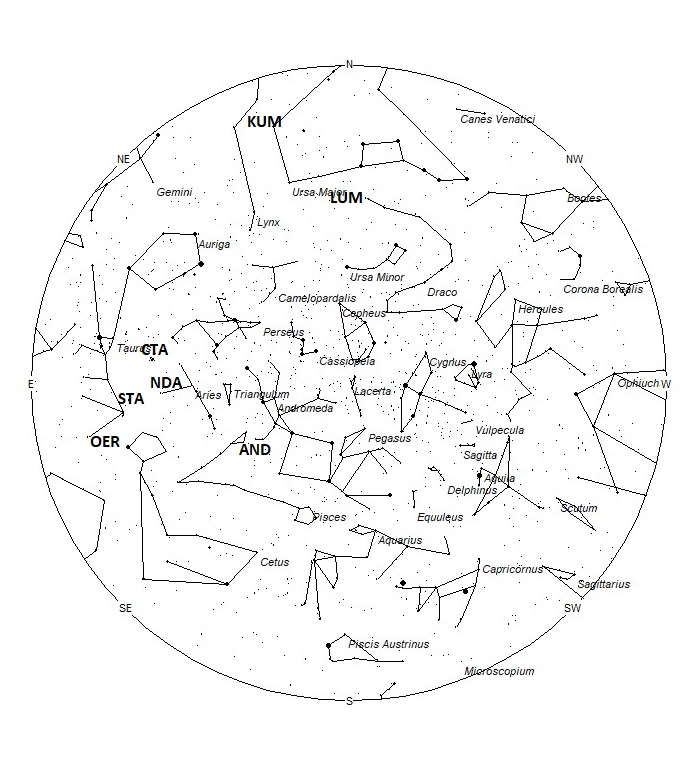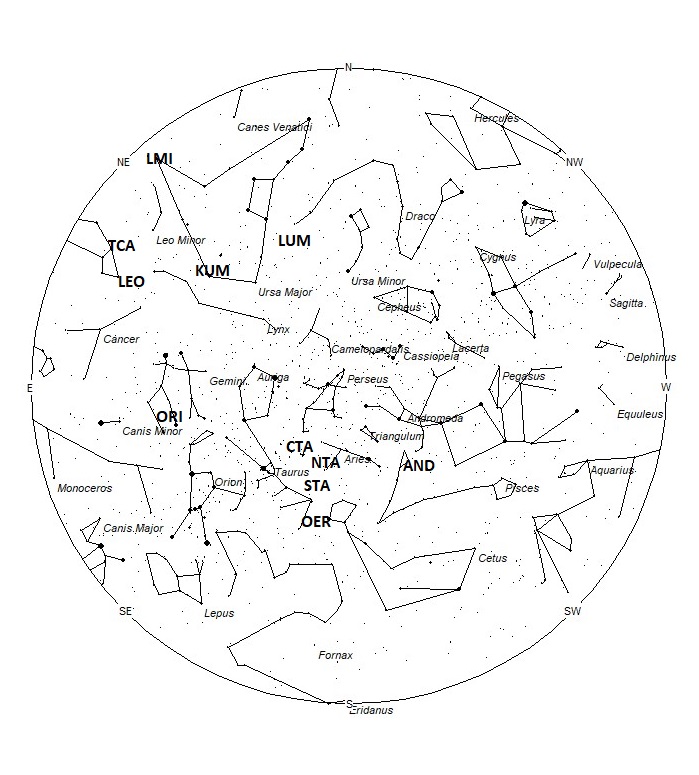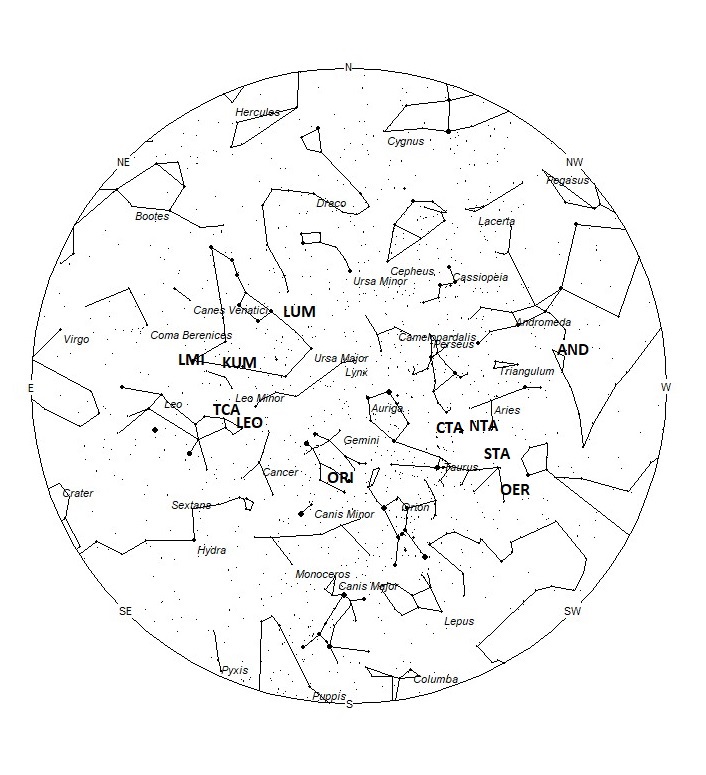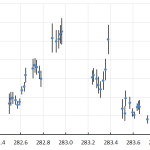As seen from the Northern Hemisphere, meteor rates continue to be strong in November. While no major activity is expected this month, the two Taurid radiants plus the Leonids keep the skies active. The addition of strong sporadic rates makes November one of the better months to view meteor activity from north of the equator. Skies are fairly quiet as seen from the Southern Hemisphere this month. Activity from the three showers mentioned above may be seen from south of the equator, but the sporadic rates are much lower than those seen north of the equator.
During this period, the moon reaches its new phase on Friday November 5th. At that time the moon lies near the sun in the sky and is invisible at night. This weekend the waning crescent moon will rise during the early morning hours but will not spoil meteor observations as long as you keep the moon out of your field of view. The estimated total hourly meteor rates for evening observers this week is near 4 as seen from mid-northern latitudes (45N) and 3 as seen from tropical southern locations (25S). For morning observers, the estimated total hourly rates should be near 20 as seen from mid-northern latitudes (45N) and 16 as seen from tropical southern locations (25S). The actual rates will also depend on factors such as personal light and motion perception, local weather conditions, alertness, and experience in watching meteor activity. Note that the hourly rates listed below are estimates as viewed from dark sky sites away from urban light sources. Observers viewing from urban areas will see less activity as only the brighter meteors will be visible from such locations.
The radiant (the area of the sky where meteors appear to shoot from) positions and rates listed below are exact for Saturday night/Sunday morning October 30/31. These positions do not change greatly day to day so the listed coordinates may be used during this entire period. Most star atlases (available at science stores and planetariums) will provide maps with grid lines of the celestial coordinates so that you may find out exactly where these positions are located in the sky. I have also included charts of the sky that display the radiant positions for evening, midnight, and morning. The center of each chart is the sky directly overhead at the appropriate hour. These charts are oriented for facing south but can be used for any direction by rotating the charts to the desired direction. A planisphere or computer planetarium program is also useful in showing the sky at any time of night on any date of the year. Activity from each radiant is best seen when it is positioned highest in the sky, either due north or south along the meridian, depending on your latitude. It must be remembered that meteor activity is rarely seen at the radiant position. Rather they shoot outwards from the radiant, so it is best to center your field of view so that the radiant lies at the edge and not the center. Viewing there will allow you to easily trace the path of each meteor back to the radiant (if it is a shower member) or in another direction if it is sporadic. Meteor activity is not seen from radiants that are located far below the horizon. The positions below are listed in a west to east manner in order of right ascension (celestial longitude). The positions listed first are located further west therefore are accessible earlier in the night while those listed further down the list rise later in the night.
These sources of meteoric activity are expected to be active this week.
.
The Andromedids (AND) are the annual debris encountered from the remains of comet 3D/Biela. These meteors should not be mistaken for the great meteor storms of the 19th century as those meteors are in a slightly different orbit and irregularly encountered in early December. They are known as the December phi Cassiopeiids (DPC). It is interesting that during November, this radiant moves northward toward the area of the DPC’s but ends before reaching the DPC radiant. The radiant currently is located near 00:58 (015) +19. This position lies in northern Pisces, 5 degrees south of the 4th magnitude star known as eta Andromedae. This part of the sky is best placed near 2200 local standard time (LST), when the radiant lies highest above the horizon. Current rates would most likely be less than 1 per hour no matter your location. With an entry velocity of 19 km/sec., the average Andromedid meteor would be of very slow velocity.
The omicron Eridanids (OER) was discovered by the Japanese video meteor network SonotaCo from video data obtained during 2007-2008. These meteors are active from October 23 through December 2nd. Maximum activity is ill-defined and may occur anytime from November 3-27. The date listed in the table represents the midpoint of the activity curve and not the actual date of maximum activity. The radiant is currently located at 03:18 (50) +00, which is located in northeastern Cetus, 4 degrees southeast of the 3rd magnitude star known as Menkar (alpha Ceti). This radiant is best placed near 0100 local standard time (LST), when it lies on the meridian and is located highest in the sky. Rates at this time should be less than 1 per hour no matter your location. With an entry velocity of 30 km/sec., the average OER meteor would be of medium-slow velocity.
The Northern Taurids (NTA) are active from a large radiant is located at 03:18 (50) +21. This area of the sky is located in eastern Aries, 2 degrees northeast of the 4th magnitude star known as Botein (delta Arietis). This radiant is best placed near 0100 LST, when it lies on the meridian and is located highest in the sky. Maximum activity is not until November 12th so rates at this time should be only 1 per hour as seen from the Northern Hemisphere and less than 1 as seen from south of the equator. With an entry velocity of 29 km/sec., the average NTA meteor would be of medium-slow velocity.
The Southern Taurids (STA) are active from a large radiant is located at 03:18 (50) +14. This area of the sky is located in southeastern Aries, 6 degrees southeast of the 4th magnitude star known as Botein (delta Arietis). This radiant is best placed near 0100 LST, when it lies on the meridian and is located highest in the sky. Current rates should be near 4 per hour no matter your location. With an entry velocity of 28 km/sec., the average STA meteor would be of medium-slow velocity.
The chi Taurids (CTA) were discovered by Dr. Peter Brown during his 7-year survey using the Canadian Meteor Orbit Radar (CMOR). This source is active from October 24 through November 13 with a maximum occurring near November 4th. The radiant is currently located at 04:00 (060) +27, which places it in western Taurus, 3 degrees northeast of the naked eye open cluster known as the Pleiades. These meteors may be seen all night long but the radiant is best placed near 0100 LST when it lies on the meridian and is located highest in the sky. Current rates should be less than 1 per hour no matter your location. With an entry velocity of 41 km/sec., the average chi Taurid meteor would be of medium velocity.
The Orionids (ORI) are active from September 26 through November 22, with maximum activity occurring on October 21st. The radiant is currently located at 06:51 (103) +16, which places it in southwestern Gemini, 3 degrees east of the 2nd magnitude star known as Alhena (gamma Geminorum). This area of the sky is best placed near 04:00. Current rates are expected to be near 5 per hour, no matter your location. With an entry velocity of 65 km/sec., the average ORI meteor would be of swift velocity.
The epsilon Geminids (EGE) are active from a radiant located at 07:27 (112) +26. This area of the sky lies in eastern Gemini, 4 degrees southwest of the 1st magnitude star known as Pollux (beta Geminorum). This area of the sky is best placed during the last dark hour prior to dawn. These meteors are active from September 27 through November 8, with maximum activity occurring on October 18. Rates at this time should be less than 1 per hour no matter your location. With an entry velocity of 68 km/sec., the average EGE meteor would be of swift velocity.
The kappa Ursae Majorids (KUM) were discovered by cameras of the SonotaCo network in Japan during an outburst of activity on November 5, 2009. This radiant is active from October 28-November 17, with maximum activity occurring on the 5th. The radiant is currently located at 09:15 (139) +47. This position lies in southwestern Ursa Majoris, 1 degree east of the 4th magnitude star known as Alkafzah (kappa Ursae Majoris A). Rates are expected to be less than 1 regardless of your location. These meteors are best seen during the last hour before dawn when the radiant lies highest above the horizon in a dark sky. With an entry velocity of 66 km/sec., the average Kappa Ursae Majorid meteor would be of swift velocity.
The Leonids (LEO) are active from November 03-December 02 with maximum activity occurring on November 18th. The radiant is currently located at 09:32 (143) +29. This position lies in northwestern Leo, 4 degrees northeast of the 4th magnitude star known as Al Min’ħar al A’sad (kappa Leonis). The Leonid radiant is best placed during the last hour before morning twilight when the radiant lies highest in a dark sky. Leonids may be seen from the Southern Hemisphere, but the viewing conditions are not quite as favorable as those north of the equator. Current rates are expected to be less than 1 per hour no matter your location. With an entry velocity of 69 km/sec., most activity from this radiant would be of swift speed with numerous persistent trains on the brighter meteors.
The tau Cancrids (TCA) are a weak shower with a long activity period of seven weeks. They are active from September 23 through November 12 with maximum activity occurring on October 22. The radiant currently lies at 09:49 (147) +29, which places it in northwestern Leo, 3 degrees north of the 4th magnitude star known as Rasalas (mu Leonis). Expected hourly rates are less than 1 per hour no matter your location. With an entry velocity of 67 km/sec., the average TCA meteor would be of swift velocity.
The Southern lambda Draconids (SLD) were discovered by Željko Andreić and the Croatian Meteor Network team based on studying SonotaCo and CMN observations (SonotaCo 2007-2011, CMN 2007-2010). These meteors are active from October 29-November 8 with maximum activity occurring on November 4th. The radiant is currently located at: 10:22 (155) +70. This area of the sky is currently located in a remote area of northwestern Ursa Major. See the charts for the exact location. This area of the sky is best placed in the sky during the last hour before dawn, when it lies highest above the horizon in a dark sky. Current rates should be less than 1 per hour no matter your location. With an entry velocity of 49km/sec., most activity from this radiant would be of medium-swift speed.
The lambda Ursa Majorids (LUM) were discovered by Željko Andreić and the Croatian Meteor Network team based on studying SonotaCo and CMN observations (SonotaCo 2007-2011, CMN 2007-2010). These meteors are active from October 18 through November 7, with maximum activity occurring on October 28th. The current location of the LUM radiant lies near 10:46 (162) +48. This area of the sky lies in southern Ursa Major, 5 degrees northwest of the 3rd magnitude star known as psi Ursae Majoris. This area of the sky is best placed in the sky during the last hour before dawn, when it lies highest above the horizon in a dark sky. Current rates should be less than 1 per hour no matter your location. With an entry velocity of 61km/sec., most activity from this radiant would be of swift speed.
The last of the Leonis Minorids (LMI) are expected this week from a radiant is located at 11:19 (170) +34. This area of the sky lies in southern Ursa Major, near the spot occupied by the 3rd magnitude star known as nu Ursae Majoris. The radiant is best placed just before dawn when it lies highest in a dark sky. This shower is better situated for observers situated in the Northern Hemisphere where the radiant rises far higher into the sky before the start of morning twilight. Current rates would be less than 1 no matter your location. At 61km/sec., the average Leonis Minorid is swift. From my personal experience this minor shower produces a high proportion of bright meteors.
As seen from the mid-northern hemisphere (45N) one would expect to see approximately 10 sporadic meteors per hour during the last hour before dawn as seen from rural observing sites. Evening rates would be near 3 per hour. As seen from the tropical southern latitudes (25S), morning rates would be near 7 per hour as seen from rural observing sites and 2 per hour during the evening hours. Locations between these two extremes would see activity between the listed figures.
You can keep track of the activity of these meteor showers as well as those beyond the limits of visual observing by visiting the NASA Meteor Shower Portal available at: https://meteorshowers.seti.org/ You can move the sky globe to see different areas of the sky. Colored dots indicate shower meteors while white dots indicate sporadic (random) activity. The large orange disk indicates the position of the sun so little activity will be seen in that area of the sky.
| SHOWER | DATE OF MAXIMUM ACTIVITY | CELESTIAL POSITION | ENTRY VELOCITY | CULMINATION | HOURLY RATE | CLASS |
| RA (RA in Deg.) DEC | Km/Sec | Local Standard Time | North-South | |||
| Andromedids (AND) | Nov 06 | 00:58 (015) +19 | 19 | 23:00 | <1 – <1 | IV |
| omicron Eridanids (OER) | Nov 13 | 03:18 (50) +00 | 30 | 01:00 | <1 – <1 | IV |
| Northern Taurids (NTA) | Nov 12 | 03:18 (50) +21 | 29 | 01:00 | 1 – <1 | II |
| Southern Taurids (STA) | Nov 05 | 03:18 (50) +14 | 28 | 01:00 | 4 – 4 | II |
| chi Taurids (CTA) | Nov 04 | 04:00 (060) +27 | 41 | 01:00 | <1 – <1 | IV |
| Orionids (ORI) | Oct 21 | 06:51 (103) +16 | 65 | 04:00 | 5 – 5 | I |
| epsilon Geminids (EGE) | Oct 18 | 07:27 (112) +26 | 68 | 05:00 | <1 – <1 | II |
| kappa Ursae Majorids (KUM) | Nov 05 | 09:15 (139) +47 | 66 | 07:00 | <1 – <1 | IV |
| Leonids (LEO) | Nov 18 | 09:32 (143) +29 | 69 | 07:00 | <1 – <1 | I |
| tau Cancrids (TCA) | Oct 22 | 09:49 (147) +29 | 67 | 07:00 | <1 – <1 | IV |
| lambda Ursa Majorids (LUM) | Oct 28 | 10:16 (154) +51 | 61 | 08:00 | <1 – <1 | IV |
| Leonis Minorids (LMI) | Oct 21 | 10:48 (162) +36 | 61 | 09:00 | <1 – <1 | II |







